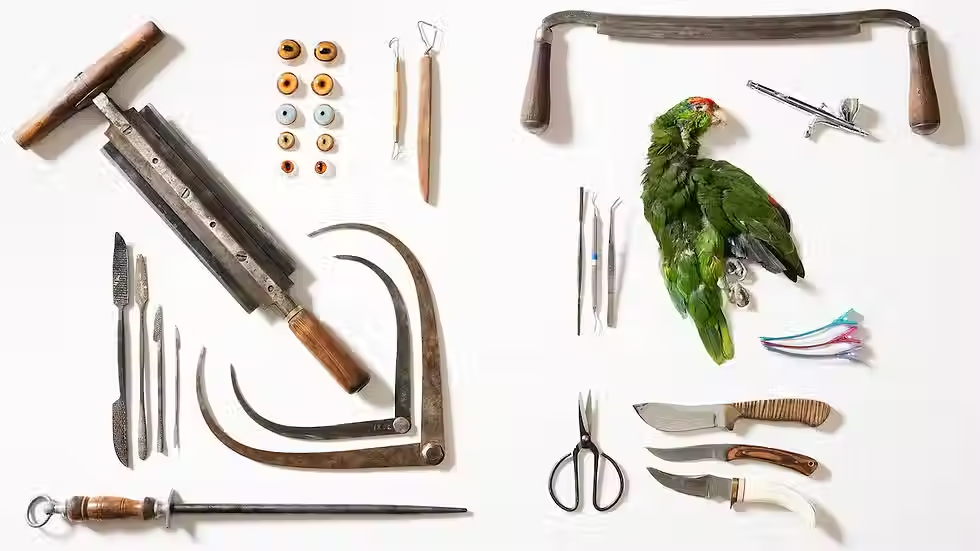Exploring the Craftsmanship Behind High-Quality Taxidermy
- Laura-Ashley Huckerby

- Aug 19
- 4 min read
Taxidermy art is a fascinating blend of science, skill, and creativity. It captures the beauty of wildlife in a way that preserves their natural form for generations to come. Behind every lifelike mount lies a meticulous process that requires patience, precision, and an eye for detail. This article delves into the craftsmanship behind high-quality taxidermy art, revealing the techniques and dedication that make it a respected art form.
The Art and Science of Taxidermy Art
Taxidermy art is much more than simply stuffing an animal’s skin. It involves a deep understanding of anatomy, biology, and aesthetics. The goal is to recreate the animal’s natural appearance as accurately as possible. This requires knowledge of muscle structure, fur patterns, and even the animal’s typical posture and behaviour.
A taxidermist begins by carefully skinning the animal, preserving the hide and important features such as the eyes and ears. The skin is then tanned to prevent decay. Meanwhile, a form or mannequin is sculpted or selected to match the animal’s size and shape. The tanned skin is mounted onto this form, and the taxidermist adjusts the positioning to achieve a lifelike pose.
The finishing touches include setting glass eyes, grooming the fur, and painting details to enhance realism. Each step demands skill and attention to detail, ensuring the final piece is both scientifically accurate and artistically compelling.

Materials and Tools Essential for Taxidermy Art
Creating high-quality taxidermy art requires specialised materials and tools. The choice of materials can significantly affect the durability and appearance of the finished piece.
Mannequins and Forms: These are often made from polyurethane foam or fiberglass. Custom forms can be sculpted to match specific species and poses.
Preservatives and Tanning Agents: Chemicals like borax and alum are used to preserve the skin and prevent bacterial growth.
Glass Eyes: Realistic glass eyes are crucial for bringing the mount to life. They come in various sizes and colours to match different species.
Sewing and Mounting Tools: Needles, thread, wires, and adhesives are used to assemble and secure the skin onto the form.
Painting Supplies: Airbrushes and paints help add colour details to areas like the nose, mouth, and around the eyes.
Using high-quality materials ensures the longevity of the taxidermy art. It also allows the artist to achieve a level of detail that makes the piece indistinguishable from a living animal.

Techniques That Define Museum-Quality Taxidermy
Achieving museum quality taxidermy requires mastery of several advanced techniques. These techniques elevate a mount from a simple display to a work of art worthy of exhibition.
Anatomical Accuracy: Understanding the skeletal and muscular structure is essential. Artists often study reference photos, skeletons, and live animals to capture the correct proportions.
Skin Preparation: Proper skinning and tanning prevent shrinkage and distortion. This step is critical for maintaining the animal’s natural texture and colour.
Posing and Expression: The pose should reflect the animal’s natural behaviour. Whether it’s a predator mid-stalk or a bird in flight, the pose adds life and storytelling to the piece.
Detailing: Adding fine details such as whiskers, claws, and subtle colour variations enhances realism.
Mounting and Display: The base and background can complement the mount, creating a naturalistic scene that enhances the viewer’s experience.
These techniques require years of practice and a passion for wildlife. The result is a taxidermy piece that educates, inspires, and preserves nature’s beauty.

Preserving and Caring for Taxidermy Art
Once a taxidermy piece is completed, proper care is essential to maintain its appearance and prevent deterioration. Here are some practical tips for preserving taxidermy art:
Avoid Direct Sunlight: UV rays can fade fur and paint.
Control Humidity: Excess moisture can cause mold and attract pests.
Regular Dusting: Use a soft brush or low-powered vacuum to remove dust gently.
Pest Prevention: Inspect regularly for insects like dermestid beetles that can damage the skin. Taxidermy prevention sprays can be purchased.
Professional Maintenance: For valuable pieces, periodic check-ups by a taxidermist can help address any issues early.
By following these guidelines, collectors and enthusiasts can ensure their taxidermy art remains vibrant and intact for decades.
The Cultural and Educational Value of Taxidermy Art
Taxidermy art plays an important role beyond decoration. It serves as a bridge between people and wildlife, fostering appreciation and understanding of animal species.
Museums use taxidermy to educate the public about biodiversity, conservation, and natural history. A well-crafted mount can tell stories about an animal’s habitat, behaviour, and ecological role. This educational aspect makes taxidermy a valuable tool for wildlife awareness.
Moreover, taxidermy art preserves specimens that might otherwise be lost to time. It allows future generations to study and admire animals that may become rare or extinct.
Collectors and enthusiasts also find personal meaning in taxidermy, connecting with nature through the artistry and craftsmanship involved.
Exploring the craftsmanship behind taxidermy art reveals a world of dedication, skill, and passion. From the careful preparation of materials to the intricate detailing and preservation, every step contributes to creating a piece that honours the natural world. Whether displayed in museums or private collections, high-quality taxidermy art continues to captivate and educate, preserving the beauty of wildlife for years to come. For those interested in exceptional examples, exploring museum quality taxidermy can provide inspiration and insight into this unique art form.








Comments